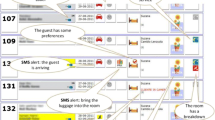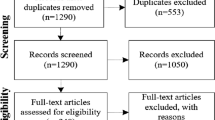Abstract
People access applications and services through different devices depending on location and needs. During a single day, people can use a smartphone, tablet, PC and a TV, sequentially or simultaneously, depending on the context of use. Even within a single task, people often start with one device, such as a smartphone, and continue with another device, such as a PC, as the task evolves. To provide fluent task continuation, the system should provide ways to migrate on-going sessions from one device to another in a seamless manner. In this paper, we present a solution for migrating user interface and maintaining the interaction session across devices when changing situations. With two studies we gain insights into user needs and technical requirements for context-aware information sharing in multi-device environments. A longitudinal diary study was conducted to uncover specific situations where users have needs for information sharing, and how they would prefer the system to react in those situations. We also conducted a controlled user study using a prototype system for session migration between devices in changing contexts, with three different operational modes: manual, assisted and automatic, to gain a deeper knowledge into the requirements. The findings indicate a need for easier interaction whilst switching between devices and that these needs are often situation-specific. We also report in detail how people would prefer the system to perform migrations automatically and intelligently suggest them in some situations. Moreover, we draw technical requirements for such a system in order to develop seamless context-aware migration.












Similar content being viewed by others
References
Adomavicius G, Tuzhilin A (2011) Context-aware recommender systems. Recommender Systems Handbook. Springer, New York, pp 217–253
Ballendat T, Marquardt N, Greenberg S (2010) Proxemic interaction: designing for a proximity and orientation-aware environment. In: Proc. ITS’10, pp 121–130
Brdiczka O (2010) Integral framework for acquiring and evolving situations in smart environments. J Ambient Intell Smart Environ 2(2):91–108
Cheverst K, Dix A, Fitton D, Kray C, Rouncefield M, Sas C, Saslis-Lagoudakis G, Sheridan JG (2005) Exploring bluetooth-based mobile phone interaction with the Hermes photo display. In: Proceedings of MobileHCI 2005, pp 47–54
Dearman D, Pierce JS (2008) It’s on my other computer! Computing with multiple devices. In: Proceedings of CHI 2008, pp 1144–1153
Dees W (2011) Usability of nomadic user interfaces. In: Proc. HCII 2011, pp 195–204
Doryab A, Togelius J, Bardram JE (2012) Activity-aware recommendation for collaborative work in operating rooms. In: Proc. IUI 2012, pp 301–304
Fischer C, Gellersen H, Gostner R, Guinard D, Kortuem G, Kray C, Rukzio E, Strengin S (2009) Supporting device discovery and spontaneous interaction with spatial references. Pers Ubiquitous Comput 13(4):255–264
Forrester Research (2013) The European tablet landscape. A technographics data essentials document. February 2013. http://www.forrester.com/European+Technographics+Consumer+Technology+Online+Survey+Q4+2012/-/E-SUS1711#/The+European+Tablet+Landscape/quickscan/-/E-RES91561. Accessed 16 May 2013
Ghiani G, Isoni L, Paternò F (2012a) Security in migratory interactive web applications. In: Proc. MUM 2012
Ghiani G, Paternò F, Santoro C (2012b) Push and pull of web user interfaces in multi-device environments. In: Proc. AVI 2012, pp 10–17
Google (2012) The new multi-screen world: understanding cross-platform consumer behaviour. Research Report, August 2012. http://services.google.com/fh/files/misc/multiscreenworld_final.pdf. Accessed 16 May 2013
Greenberg S, Marquardt N, Ballendat T, Diaz-Marino R, Wang M (2011) Proxemic interactions: the new ubicomp? Interactions 18:42–50
Holleis P, Otto F, Hußmann H, Schmidt (2007) A keystroke-level model for advanced mobile phone interaction. In: Proc. CHI 2007, pp 1505–1514
Könönen V, Pääkkönen P (2011) Optimizing power consumption of always-on applications based on timer alignment. In: Proc. COMSNETS 2011
Marquardt N, Diaz-Marino R, Boring S, Greenberg S (2011) The proximity toolkit: prototyping proxemic interactions in ubiquitous computing ecologies. In: Proc. UIST 2011, pp 315–326
Microsoft (2013) Cross-screen engagement: multi-screen pathways reveal new opportunities for marketers to reach and engage consumers. Microsoft Advertising, Flamingo & Ipsos OTX, USA
Nielsen J (1993) Usability engineering. Morgan Kaufman Publishers Inc., San Francisco
Pyla PS, Tungare M, Pérez-Quiñones MA (2006) Multiple user interfaces: why consistency is not everything, and seamless task migration is key. In: Proceedings of CHI 2006
Rekimoto J, Ayatsuka Y, Kohno M, Oba H (2003) Proximal Interactions: A Direct Manipulation Technique for Wireless Networking. In: Proc. Interact 2003, pp 511–518
Schilit BN, Sengupta U (2004) Device ensembles. IEEE. Computer 37:56–64
Schilit BN, Adams N, Want R (1994) Context-aware computing applications. In: Proc. WMCSA 1994, pp 85–90
Schmidt A (2000) Implicit human computer interaction through context. Pers Ubiquit Comput 4(2/3):191–199
Sellen A, Kurtenbach G, Buxton W (1992) The prevention of mode errors through sensory feedback. Human Comput Interact 7(2):141–164
Smarcos Project (2012) http://www.smarcos-project.eu/. Accessed 16 May 2013
Wäljas M, Segerståhl K, Väänänen-Vainio-Mattila K, Oinas-Kukkonen H (2010) Cross-platform service user experience: a field study and an initial framework. In: Proc. MobileHCI 2010, pp 219–228
Acknowledgments
The support from the European Union ARTEMIS Smarcos project (2012) is gratefully acknowledged.
Author information
Authors and Affiliations
Corresponding author
Electronic supplementary material
Below is the link to the electronic supplementary material.
Rights and permissions
About this article
Cite this article
Ghiani, G., Polet, J., Antila, V. et al. Evaluating context-aware user interface migration in multi-device environments. J Ambient Intell Human Comput 6, 259–277 (2015). https://doi.org/10.1007/s12652-013-0214-7
Received:
Accepted:
Published:
Issue Date:
DOI: https://doi.org/10.1007/s12652-013-0214-7




